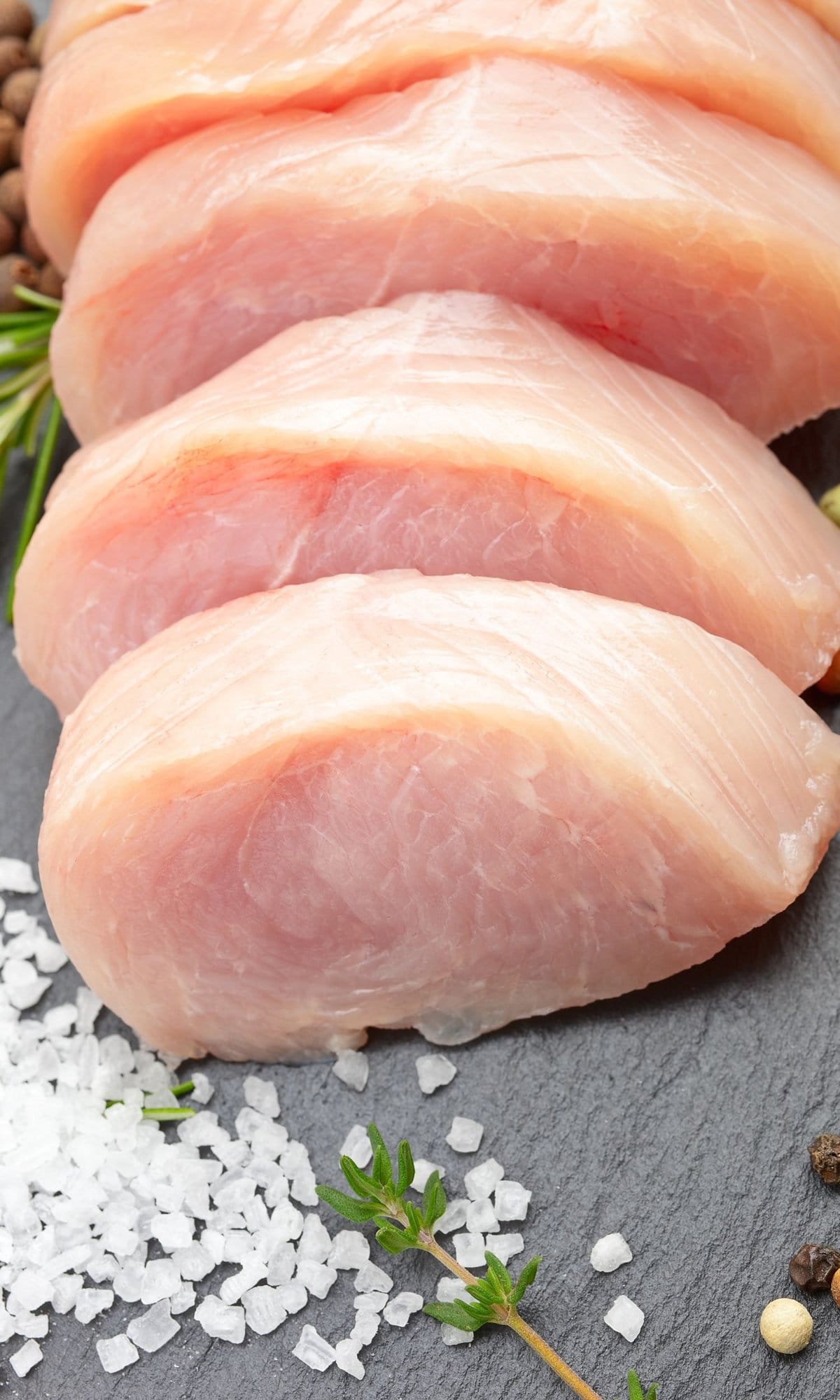Chicken Breast Nutrition Facts
Chicken breast is a versatile and delicious protein source that many of us enjoy regularly. Whether you prefer it grilled, baked, or pan-seared, this lean cut of meat can be a healthy addition to your diet. In this blog post, we’ll explore the chicken breast nutrition facts, including its benefits, serving sizes, and various cooking methods. So, let’s dive right in and discover the nutritional goodness of chicken breast!

Chicken Breast: A Nutritional Powerhouse
Before we delve into the nutrition facts, let’s uncover the impressive nutritional profile of chicken breast. This culinary gem is more than just a lean cut of meat; it’s a treasure trove of health benefits waiting to be explored.
Chicken Breast Nutrition Facts
Basic Nutrition Information
When it comes to nutrition, chicken breast is a powerhouse of essential nutrients. Here’s a breakdown of the basic nutrition information for a 4-ounce (113-gram) serving of boneless, skinless chicken breast:
Calories:
A 4-ounce serving of chicken breast typically contains around 110-120 calories. This makes it an excellent choice for those watching their calorie intake.
Protein:
One of the standout features of chicken breast is its high protein content. In a 4-ounce serving, you can find approximately 27 grams of protein. Protein is essential for muscle growth and repair, making chicken breast a favorite among fitness enthusiasts.
Fat:
Chicken breast is low in fat, with a 4-ounce serving containing only 1-2 grams of fat. This is primarily unsaturated fat, which is considered heart-healthy.
Carbohydrates:
Chicken breast is virtually carb-free, making it a suitable option for low-carb or ketogenic diets.
Vitamins and Minerals:
Chicken breast is rich in essential vitamins and minerals, including vitamin B6, niacin, phosphorus, and selenium. These nutrients play crucial roles in various bodily functions, such as energy metabolism, immune system support, and bone health.
Vitamin B6: Also known as pyridoxine, vitamin B6 is vital for brain development and function, as well as for the production of neurotransmitters.
Niacin (Vitamin B3): Niacin is essential for DNA repair, supporting proper digestion, and maintaining healthy skin.
Phosphorus: This mineral plays a significant role in bone health, energy production, and kidney function.
Selenium: Selenium is an antioxidant that helps protect cells from damage, supports the immune system, and contributes to thyroid health.

Benefits of Chicken Breast Nutrition
Now that we’ve looked at the basic nutrition facts and the vitamins and minerals found in chicken breast, let’s explore the numerous benefits of incorporating this poultry into your diet:
1. High-Quality Protein:
As mentioned earlier, chicken breast is an excellent source of high-quality protein. Protein is essential for building and repairing tissues, supporting muscle health, and aiding in weight management.
2. Low in Calories:
If you’re watching your calorie intake, chicken breast is a fantastic choice. Its low-calorie content allows you to enjoy a satisfying meal without consuming excess calories.
3. Low in Fat:
Chicken breast is naturally low in fat, especially when you opt for the boneless, skinless variety. This makes it a heart-healthy option that can help reduce your saturated fat intake.
4. Versatility:
Chicken breast is incredibly versatile in the kitchen. You can prepare it in numerous ways, from grilling and baking to sautéing and stir-frying. Its mild flavor also makes it a perfect canvas for various seasonings and marinades.
5. Nutrient-Rich:
In addition to its protein content, chicken breast provides essential vitamins and minerals that support overall health. These nutrients contribute to better energy levels, immune function, and bone health.
Serving Sizes and Nutrition
The nutrition content of chicken breast can vary based on serving size. Here’s a breakdown of the nutrition facts for both a 4-ounce and an 8-ounce serving of boneless, skinless chicken breast:
4 oz. Chicken Breast Nutrition:
- Calories: Approximately 110-120
- Protein: Around 27 grams
- Fat: 1-2 grams
- Carbohydrates: Negligible
- Vitamins and Minerals: Rich in vitamin B6, niacin, phosphorus, and selenium
8 oz. Chicken Breast Nutrition:
- Calories: Approximately 220-240
- Protein: Around 54 grams
- Fat: 2-4 grams
- Carbohydrates: Minimal
- Vitamins and Minerals: Abundant in vitamin B6, niacin, phosphorus, and selenium
It’s essential to consider your dietary needs and portion sizes when incorporating chicken breast into your meals. While both 4-ounce and 8-ounce servings offer a healthy dose of protein, the calorie and fat content doubles in the larger serving size.

Cooking Methods and Nutrition
The way you cook chicken breast can affect its nutritional profile. Let’s take a closer look at the impact of different cooking methods:
Grilled Chicken Breast Nutrition
Grilling chicken breast is a popular and healthy cooking method that imparts a smoky flavor and beautiful grill marks. Here’s how grilling affects the nutrition of chicken breast:
- Calories: Grilled chicken breast retains its low-calorie status, with approximately 110-120 calories per 4-ounce serving.
- Protein: Grilling doesn’t significantly affect the protein content, so you still get around 27 grams per serving.
- Fat: Grilled chicken breast remains low in fat, with 1-2 grams of fat per 4-ounce serving.
- Carbohydrates: Grilling doesn’t add carbohydrates to your chicken breast.
- Vitamins and Minerals: Grilled chicken breast retains its rich nutrient content, providing vitamin B6, niacin, phosphorus, and selenium.
Grilled chicken breast is not only nutritious but also incredibly flavorful, making it a favorite choice for many health-conscious individuals.
Other Cooking Methods
While grilling is a popular option, there are various other ways to prepare chicken breast, such as baking, sautéing, and poaching. Here’s a brief overview of how these methods impact the nutrition of chicken breast:
- Baked Chicken Breast: Baking chicken breast preserves its low-calorie, high-protein, and low-fat characteristics. It’s a healthy option, especially when seasoned with herbs and spices.
- Sautéed Chicken Breast: When sautéed with minimal oil, chicken breast can remain relatively low in fat and calories. However, the total fat content may slightly increase due to the added cooking oil.
- Poached Chicken Breast: Poaching chicken breast in simmering water maintains its lean profile. It’s a gentle cooking method that keeps the chicken moist and tender.
Have frozen chicken that you’d like to cook? Learn how to defrost chicken.
Exploring the Bounty of Chicken Breasts
In closing, chicken breast is not just a delicious and versatile protein source; it’s also a nutritional powerhouse. By incorporating this lean meat into your meals, you’re not only enjoying a protein-rich food but also reaping the benefits of essential vitamins and minerals like vitamin B6, niacin, phosphorus, and selenium.
Whether you’re aiming to build muscle, maintain a healthy weight, or simply savor a tasty meal, chicken breast has you covered. So, embrace the versatility and nutritional benefits of chicken breast, and elevate your culinary experiences while nourishing your body with essential nutrients.
Next time you’re at the grocery store or planning your meals, remember the nutritional treasure that chicken breast offers, and let your creativity soar in the kitchen. Enjoy the wholesome goodness and health benefits that this lean protein brings to your table.